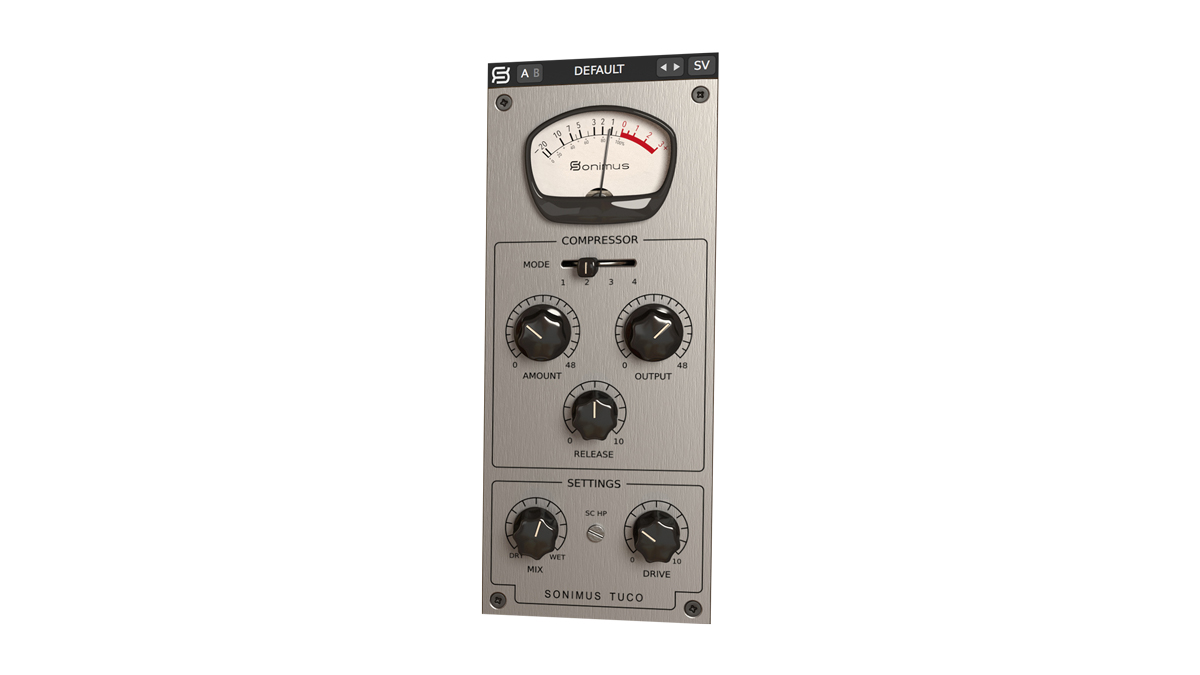MusicRadar Verdict
It may not be the most flexible vari-mu plugin available, but TuCo is well implemented and sounds great.
Pros
- +
Compressor and limiter modes.
- +
Sidechain high-pass.
- +
Two linking options for stereo compression.
Cons
- -
No mid/side operation.
MusicRadar's got your back
TuCo (AU, VST, VST3, AAX) is a new compressor plugin from Sonimus, based on a vari-mu-style valve circuit with feedback topology.
The main controls are Amount (threshold), Release and Output, with a fourth control (Mode) selecting either compressor or limiter behaviour. There are slow and fast attack options for each behaviour (so four Modes in total), and in typical vari-mu fashion, the associated ratios are variable with compression between 1.5:1 and 3:1, and limiting between 4:1 and 10:1.
Clicking the VU-style level meter reveals three metering options (input, output and gain reduction). Meanwhile, at the bottom of the interface, you’ll find output Mix blend, sidechain high-pass filter (10Hz to 350Hz) and output Drive, which is a separate post-compression valve saturation processor.
TuCo has a few less obvious features. You can choose one of four stereo processing modes, clicking the Amount label reveals an auto gain makeup setting (AMG), and clicking on the Mix control reveals the option to move the Mix blend before or after the Output level control.
When it’s set to run before the Output, the dry signal is gain-compensated, so you can simply set your desired parallel mix blend and then use the Output to set the overall output level. Set to the post-output setting, the Output control determines the level of the wet signal, while the dry signal is left as is. Bear in mind that in both cases, the signal still has to pass through the valve Drive processor.
Mu do something to me
TuCo includes a good selection of around 50 categorised presets and a simple browser that allows easy creation of new categories and presets. There are plenty of drum settings demonstrating everything from snare and kick levelling to more punchy aggressive processing. Perhaps surprisingly, most of these presets make use of the Drive parameter, and this is definitely one key aspect of the design, even though it sits outside the compression circuit.
A stereo instance of TuCo includes four linking modes. One of these is actually Mono, summing the stereo input and processing it as a single channel to produce a mono output.
Meanwhile, one is simply Dual Mono, processing each channel independently (albeit with shared parameter controls), using independent detector circuits and sidechains to produce a dual mono output.
The true stereo options are called Vintage and Modern. Vintage applies a pretty familiar technique, using a summed sidechain to feed a single detector circuit. The resultant gain reduction is then applied equally to both channels. Modern takes a slightly different approach with separate detector circuits for each channel. Gain reduction is then applied equally to both channels based on whichever channel detector produces the greater value.
Overall, we found Vintage delivered a predictable open stereo image, while Modern was more sensitive to transients.
With the Drive set to zero, TuCo still delivers an excellent range of drum flavours, ranging from super-fast transient-nailing to more lazy-attack, fast-release snappy sounds. On kicks, the sidechain high-pass is particularly welcome, allowing us to really bring out the attack without distorting the body of the sound.
On drum kit room mics, meanwhile, you can really enhance energy, and the Release envelope seems particularly well suited to drums. Even so, TuCo can do less audible compression if required, and piano, acoustic guitar, vocals and picked electric guitar are all very easy to enhance.
So, what of the Drive option? This can add some extra presence to sounds (with both odd and even harmonics showing up on our analyser), although bass heavy sounds can begin to saturate at high settings, so a little care is wise. As mentioned, this parameters sits after the compressor, so the output level influences things too.
Overall, TuCo is a well-thought-out and pretty simple compressor/limiter, and although we’d like to see a mid/side mode, it nonetheless delivers a broad palette of sounds.
Computer Music magazine is the world’s best selling publication dedicated solely to making great music with your Mac or PC computer. Each issue it brings its lucky readers the best in cutting-edge tutorials, need-to-know, expert software reviews and even all the tools you actually need to make great music today, courtesy of our legendary CM Plugin Suite.
“A synthesizer that is both easy to use and fun to play whilst maintaining a decent degree of programming depth and flexibility”: PWM Mantis review
“I feel like that song had everything we needed to come back with”: Bring Me The Horizon’s Lee Malia on Shadow Moses, its riff and the secrets behind its tone, and why it was the right anthem at the right time
“I said, ‘Are we sure we can write a song about death?’”: The story of Mike + The Mechanics' classic No.1 The Living Years











